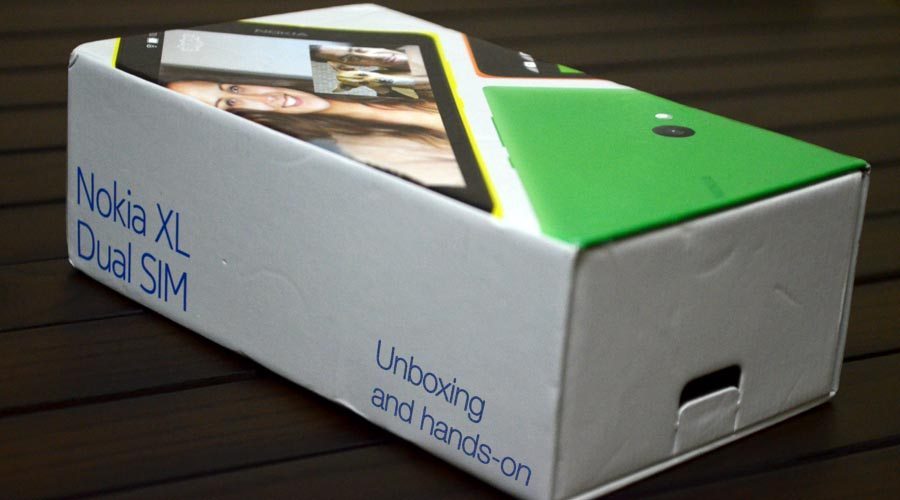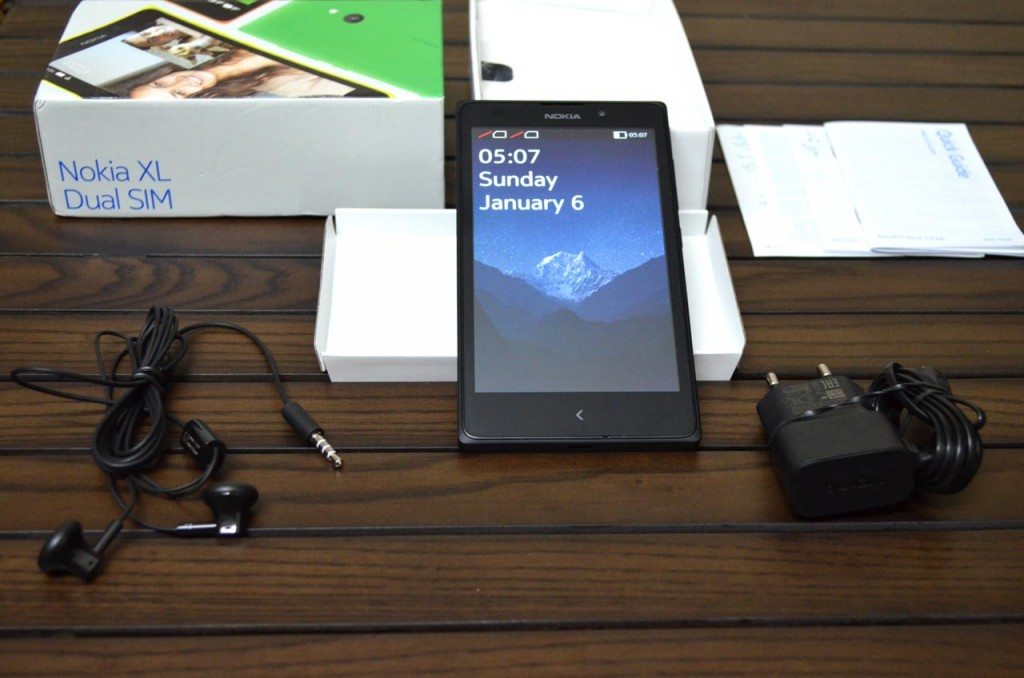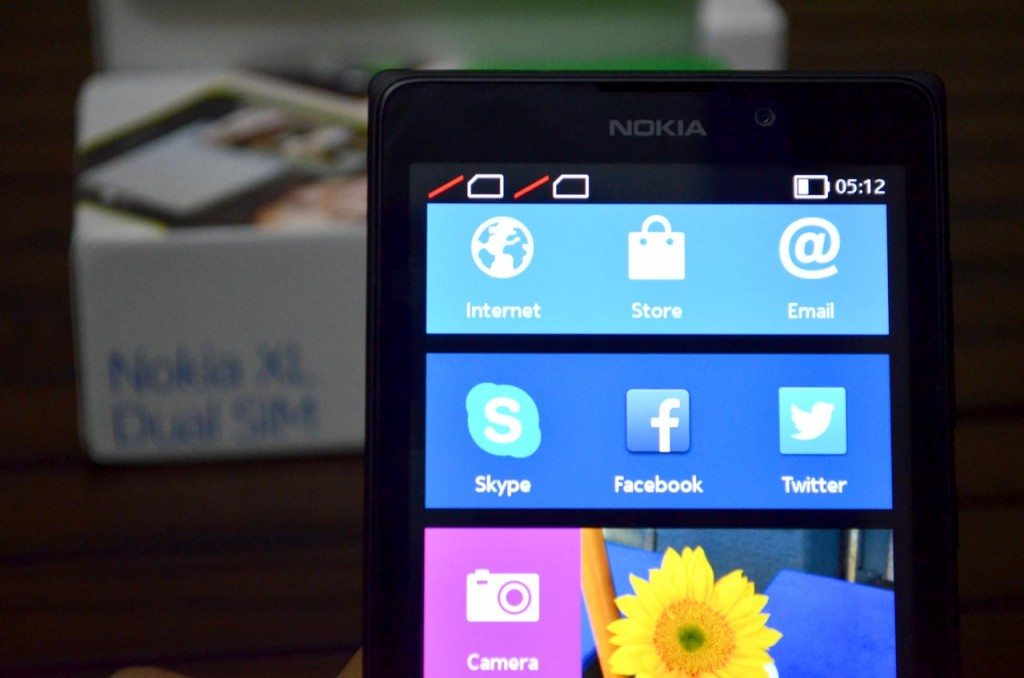So the other day I was at a fast food restaurant, and got asked the same old question. “Sir, would you like to upsize your meal?”. Obviously, I agreed. For a little price on top of what I’m already paying, I’ll be glad to get a larger serving. Well, the concept has gone a little further, into the tech world. We prefer big phones over smaller ones, and that’s primarily the reason Nokia came up with a larger version of its first ever Android phone (Nokia X). And not to our surprise, it’s called the Nokia XL. But it’s not just a larger Nokia X. It’s a better version, hence proving ‘bigger is better’. Check out our quick unboxing video, and stay tuned for more details after that.
[vimeo 99867942 w=741 h=417]
Contents of the box (in order of appearance)
Nokia XL
Manuals
Stereo headphones with mic
Wall charger
Battery
Hardware & Build Quality
In terms of looks, it’s okay to say that the XL is indeed a larger version of the Nokia X. It’s huge, compared to the X, and is significantly heavier as well. The plastic case has a leather-like feel to it. The front is fully glass, but apparently not Gorilla glass, and it’s a fingerprint magnet. The screen measures 5 inches diagonally, and has a resolution of 480×800 pixels. That comes out to be somewhere around 187 pixels per inch (ppi). Above the screen, there’s a 2 megapixels front facing camera, and it takes just good enough selfies in decent lighting conditions. There’s no LED notification light though, which has become an essential part of modern Android smartphones. There’s only one capacitive button at the bottom, which acts as a ‘back’ button and can be long tapped to go to the homescreen. The only physical buttons are on the right edge of the device, for volume and power. There’s a 3.5mm jack at the top, and a micro-USB port at the bottom. At the back, there’s a 5 megapixel camera with autofocus and an LED flash. It shoots photos at 2592×1944 pixels, and records video at VGA quality. The rear shell is removable (not so easily, I might add- my fingernails hurt). The included 2000 mAh battery has to be put in manually. Taking the shell off reveals two micro-SIM card slots and a microSD card slot. Although it’s a dual SIM phone, but only SIM 1 would have 3G connectivity. Overall, the phone is pretty sturdy if you have the pocket to carry a phone of this size (and weight).
Hands-on Approach
Here’s another friendly reminder just in case you missed it. The ‘X’ lineup of phones by Nokia is powered by Android, and so is the Nokia XL. But here’s the thing. Android is Open-Source, and for the X series, Nokia (read:Microsoft) has modified it to such an extent that it doesn’t look like Android anymore. Once you turn it on, you’re presented with a homescreen that somewhat resembles Windows Phone. But it’s not as close to as the real thing. It isn’t a perfect replica. All of the apps installed on the phone are displayed on a single, endless homescreen. There is no dedicated app drawer. You might be able to notice a few familiar features from Android. For instance, swiping from the top gives access to a few quick toggles and the settings button- but that’s about it. You might expect notifications to end up there, but that’s not the case. Notifications are also a part of ‘Fastlane’. What’s Fastlane, you ask? It’s Nokia’s approach to multitasking and notification management. Fastlane can be accessed by swiping to the left or right while being at the homescreen. It displays all the minimized apps as well as recent notifications. Nokia has also built in the ‘glance’ screen usually found on Lumia phones. The phone can know when you’ve taken it out of your pocket, and the screen would automatically turn on.
Perhaps the most prominent factor in this Android phone (compared to other Android phones) is the lack of Google integration. More specifically, you won’t find a ‘Play Store’ in the Nokia XL, not the Gmail app, hangouts, or any other installed by default. There’s Nokia’s own version of the store with most apps that are already available on the Play Store. If you can’t find a particular app on this store, try some of the third party stores like Mobango and GO Store. If all else fails, you can install APK files directly, since it’s Android after all. Other than that, a common reaction from most people is that they don’t like the look and feel of Nokia’s version of Android. That can be fixed pretty easily, by installing a third party launcher. Try one like GO Launcher, and suddenly it starts to feel a lot more like a typical Android phone.
Performance-wise, the 1GHz dual-core processor performs just well enough. There isn’t a lot of RAM on this phone, but it’s just enough to cater to your basic smartphone needs. It does occasionally get a bit warm though, especially while gaming. The battery holds up pretty well. It can easily last a day of normal use. You might even get more than a day, it totally depends on your usage.
Yaay or Nay?
So the question is, whether you should get this phone or not. Our answer is, if you’ve always wanted to get your hands on an Android powered phone by Nokia, go ahead and check it out. It might be the same Android experience as you’re used to, but it’s certainly a capable enough phone. It is priced around Rs.17,500, so considering the low price, it is a fine screen experience (can you get a decent brand’s 5” smartphone in this budget?), supports dual SIM, and runs Android. Don’t expect too much, it does the job just right!




